
Roy Fox Lichtenstein was an American pop artist. During the 1960s, along with Andy Warhol, Jasper Johns, and James Rosenquist, he became a leading figure in the new art movement. His work defined the premise of pop art through parody. Inspired by the comic strip, Lichtenstein produced precise compositions that documented while they parodied, often in a tongue-in-cheek manner. His work was influenced by popular advertising and the comic book style. His artwork was considered to be "disruptive". He described pop art as "not 'American' painting but actually industrial painting". His paintings were exhibited at the Leo Castelli Gallery in New York City.

Whaam! is a 1963 diptych painting by the American artist Roy Lichtenstein. It is one of the best-known works of pop art, and among Lichtenstein's most important paintings. Whaam! was first exhibited at the Leo Castelli Gallery in New York City in 1963, and purchased by the Tate Gallery, London, in 1966. It has been on permanent display at Tate Modern since 2006.

Little Big Painting is a 1965 oil and Magna on canvas pop art painting by Roy Lichtenstein. It is part of the Brushstrokes series of artworks that include several paintings and sculptures. It is located at the Whitney Museum of American Art in New York City. As with all of his Brushstrokes works, it is in part a satirical response to the gestural painting of abstract expressionism.

Girl with Ball is a 1961 painting by Roy Lichtenstein. It is an oil on canvas Pop art work that is now in the collection of the Museum of Modern Art, after being owned for several decades by Philip Johnson. It is one of Lichtenstein's earliest Pop art works and is known for its source, which is a newspaper ad that ran for several decades and which was among Lichtenstein's earliest works sourced from pop culture.

Look Mickey is a 1961 oil on canvas painting by Roy Lichtenstein. Widely regarded as the bridge between his abstract expressionism and pop art works, it is notable for its ironic humor and aesthetic value as well as being the first example of the artist's employment of Ben-Day dots, speech balloons and comic imagery as a source for a painting. The painting was bequeathed to the Washington, D.C., National Gallery of Art upon Lichtenstein's death.
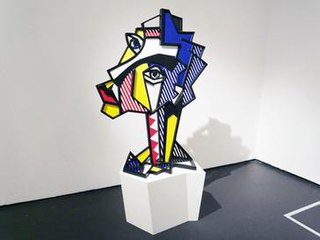
Expressionist Head by pop artist Roy Lichtenstein is the name associated with several 1980s works of art. It is widely associated with a set of six identical sculptures but is also associated with a series of paintings.

Big Painting No. 6 is a 1965 oil and Magna on canvas painting by Roy Lichtenstein. Measuring 235 cm × 330 cm, it is part of the Brushstrokes series of artworks that includes several paintings and sculptures whose subject is the actions made with a house-painter's brush. It set a record auction price for a painting by a living American artist when it sold for $75,000 in 1970. The painting is in the Kunstsammlung Nordrhein-Westfalen collection.
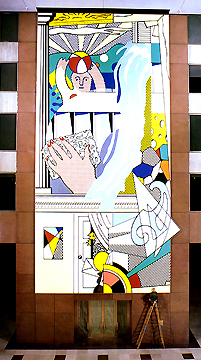
Mural with Blue Brushstroke is a 1986 mural painting by Roy Lichtenstein that is located in the atrium of the Equitable Tower in New York City. The mural was the subject of the book Roy Lichtenstein: Mural With Blue Brushstroke. The mural includes highlights of Lichtenstein's earlier works.
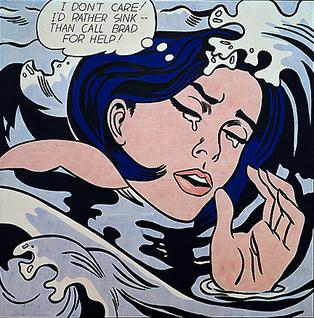
Drowning Girl is a 1963 American painting in oil and synthetic polymer paint on canvas by Roy Lichtenstein, based on original art by Tony Abruzzo. The painting is considered among Lichtenstein's most significant works, perhaps on a par with his acclaimed 1963 diptych Whaam!. One of the most representative paintings of the pop art movement, Drowning Girl was acquired by the Museum of Modern Art in 1971.

Roto Broil is a 1961 pop art painting by Roy Lichtenstein. It was one of the consumer goods paintings made in the early 1960s that "made a splash, sold well and immediately polarized the critics."
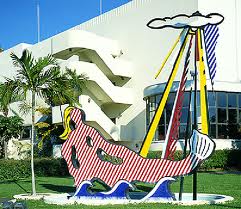
Mermaid is a 1979 outdoor sculpture by Roy Lichtenstein, composed of concrete, steel, polyurethane, enamel, palm tree, and water. It is located in Miami Beach at the Fillmore Miami Beach at Jackie Gleason Theater. Measuring 640 cm × 730 cm × 330 cm, it is his first public art commission according to some sources, although others point to a temporary pavilion that predates this work. It is also the second piece of public art in the city of Miami Beach. Since the sculpture was installed, it has been restored several times, and the theater that it accompanies has been restored and renamed twice.

Artist's Studio—Look Mickey is a 1973 painting by Roy Lichtenstein. It is one of five large-scale studio interior paintings in a series. The series is either referred to as the Artist's Studio series or more colloquially as the Studios and sometimes is described as excluding the other 1973 painting, reducing the series to four.
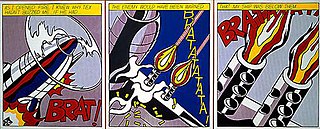
As I Opened Fire is a 1964 oil and magna on canvas painting by Roy Lichtenstein. The work is hosted at the Stedelijk Museum in Amsterdam. The source of the subject matter is Jerry Grandenetti's panels from "Wingmate of Doom," in All American Men of War, no. 90, DC Comics.
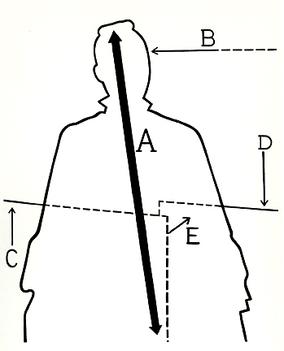
Portrait of Madame Cézanne is a 1962 pop art painting by Roy Lichtenstein. It is a quotation of Erle Loran's diagram of one of Paul Cézanne's 27 portraits of his wife Marie-Hortense Fiquet, now in the Barnes Foundation, Philadelphia. It was one of the works exhibited at Lichtenstein's first solo exhibition in Los Angeles. The work became controversial in that it led to a reconsideration of what constitutes art.

Yellow and Green Brushstrokes is a 1966 oil and Magna on canvas pop art painting by Roy Lichtenstein. It is part of the Brushstrokes series of artworks that includes several paintings and sculptures. It is located at the Museum für Moderne Kunst in Frankfurt, Germany. As with all of his Brushstrokes works, it is in part a satirical response to the gestural painting of Abstract Expressionism. It is in the collection of the Museum für Moderne Kunst.

Blam is a 1962 painting by Roy Lichtenstein falling within the pop art idiom. It is one of his military comic book derivatives and was one of the works presented at his first solo exhibition. The work is in the collection at the Yale University Art Gallery

Engagement Ring is a 1961 pop art painting by Roy Lichtenstein. The work is based on the Winnie Winkle series, but Lichtenstein changed both the graphical description and the narrative accompaniment that he presents in a speech balloon. As with most of his early romance comics works, this consisted of "a boy and a girl connected by romantic dialogue and action".

Golf Ball is a 1962 painting by Roy Lichtenstein. It is considered to fall within the art movement known as pop art. It depicts "a single sphere with patterned, variously directional semi-circular grooves." The work is commonly associated with black-and-white Piet Mondrian works. It is one of the works that was presented at Lichtenstein's first solo exhibition and one that was critical to his early association with pop art. The work is commonly critiqued for its tension involving a three-dimensional representation in two dimensions with much discussion revolving around the choice of a background nearly without any perspective.
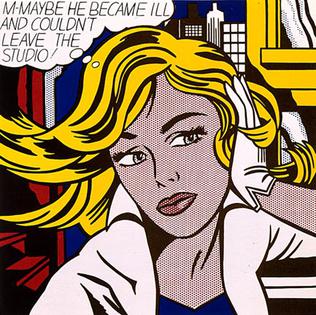
M-Maybe is a 1965 pop art painting by Roy Lichtenstein. It is one of his romance comics-based works.
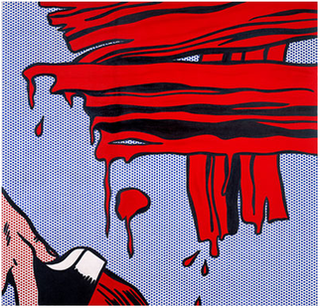
Brushstrokes is a 1965 oil and Magna on canvas pop art painting by Roy Lichtenstein. It is the first element of the Brushstrokes series of artworks that includes several paintings and sculptures. As with all of his Brushstrokes works, it is in part a satirical response to the gestural painting of Abstract Expressionism.























